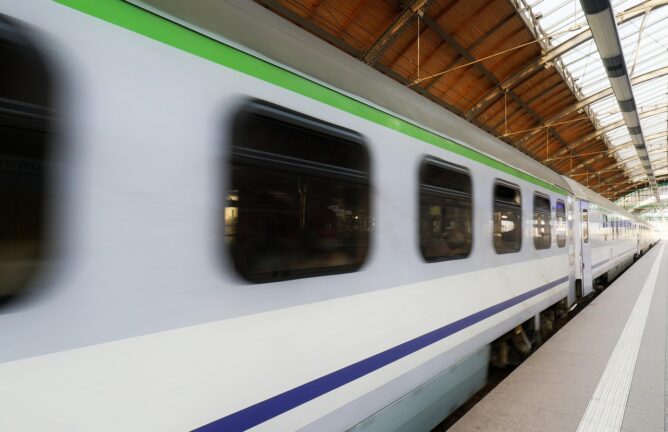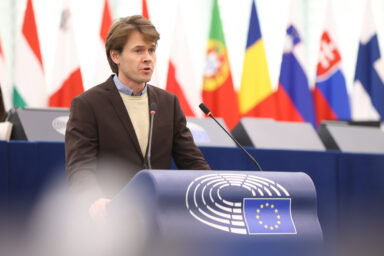The Copenhagen–Berlin train needs seven hours today. Fifteen years, half a trillion euros, and much political prayer later, it should take four. But do not buy your ticket just yet: for now, it’s only words on paper.
The European Commission sounded a celebratory air when announcing its latest moves on transport on 5 November 2025. The twin proposals—an action plan for high-speed rail and a Sustainable Transport Investment Plan—aim to bind Europe closer while weaning it off fossil fuels.
European Commission Vice-President Raffaele Fitto set the press conference’s tone with brisk certainty and unwavering optimism. “The measures we present today cover two key areas. Rail, where Europe already leads in sustainability, and fuels, where Europe is now accelerating its energy transition,” Mr Fitto said. He spoke of a continent that can already taste the benefits of speed and cleaner energy, if only it finishes the job (without ruining itself in the process).
Officials claimed the package prizes competitiveness as much as carbon. They dangled faster journeys and cheaper tickets before travellers while promising industry a better shot at growth. The underlying bet is that investment now will keep Europe ahead of rising Asian rivals.
You might be interested
Shrinking distances
Speed first. Transport Commissioner Apostolos Tzitzikostas put numbers on the dream. “Imagine traveling between Berlin and Copenhagen in four hours instead of seven,” Mr Tzitzikostas told reporters. He then listed Sofia–Athens, Zagreb–Budapest and Madrid–Lisbon as corridors slated for dramatic cuts in journey time. The target year is 2040.
Behind the optimism sits a daunting bill. Mr Tzitzikostas talked of “enormous financial resources…reaching up to 550 billion euros” to complete the network. Brussels says the benefits—more than €200bn in wider gains—justify the outlay, no matter the maths. Yet many member states struggle to maintain their existing tracks, never mind add high-speed ones.
The plan leans on four pillars: hardware, software, industry and governance. Hardware means concrete and rails; software means rules that make trains talk to each other. Industry needs bigger factories, governance sharper teeth. Each pillar relies on national treasuries as much as EU cash.
One-click digital tickets
Technology should soften borders. “We will propose legislation to improve cross-border rail ticketing and booking systems—it’s coming at the beginning of 2026—making it easier for passengers to plan and book seamless cross-border journeys just with one click,” Mr Tzitzikostas said. Later, pressed on detail, he added, “The goal is for all passengers to be able to book and to purchase a ticket cross-border through different companies and multimodally.”
That promise targets the bane of rail enthusiasts: labyrinthine websites and incompatible timetables. If Brussels can impose a single digital standard, the allure of “planes on rails” will rise. Competition regulators, already busy with low-cost airlines, may soon eye rail incumbents with fresh suspicion.
Hardware matters too. The Commission wants a fully deployed European Rail Traffic Management System, a shared digital brain that lets trains run closer together. It hopes this will boost safety and free up paths for newcomers.
Money, markets and risk
Rail still draws most headlines, but fuels took equal billing. Mr Fitto stressed cohesion: “This strategy can generate opportunities for the farming community and other stakeholders…including the refinery sector.” Here lies the transport plan’s political glue—every region gets a slice.
This strategy can generate opportunities for the farming community and other stakeholders…including the refinery sector. — Raffaele Fitto, European Commission Vice-President
Mr Tzitzikostas sounded blunter on financing. “We need 100 billion euros for investment by 2035, and we need it fast,” he said. Today’s pot, the new Sustainable Transport Investment Plan, or STIP, offers €3.4bn to “kick-start the first investments very rapidly.” That is seed money, not fertiliser. Private capital must supply the rest.
Sustainable fuels cost two to ten times more than kerosene or bunker oil. Airlines and shipping lines hesitate to sign long contracts. Brussels will test a pilot auction for synthetic aviation fuel, hoping to lower risk and match producers with buyers. If it works, investors may pile in; if not, STIP will read as another wish list.
National headaches, EU aspirin
Questions soon turned local. Reporters asked about Rail Baltica, Croatian upgrades and Greek safety. Mr Tzitzikostas assured Greece that Brussels “continues monitoring very closely” and sends technical aid. On Madrid-Lisbon he argued that “adequate funding” under the revised EU budget must pass before shovels move.
Barcelona’s omission from one map sparked worry of at least one journalist (predictably, from Catalonia) at the press conference. The Commissioner soothed Catalan pride: “All major cities will be included, including, of course, Barcelona.” The answer revealed a broader truth. Brussels can sketch corridors, but completion depends on 27 capitals clearing land, issuing permits and guarding budgets.
Italy introduced an unexpected twist. Mr Fitto noted a Wednesday Constitutional Court ruling that limits train-driver hours and hinted at possible friction with single-market rules. Labour law, safety and competitiveness may soon collide—a reminder that steel and sleepers are only part of the rail puzzle.
Need for speed (and cohesion)
Critics fear the package could widen gaps rather than close them. Western Europe already runs sleek TGVs and Frecciarossas; the east lags miles behind. Brussels replies that its maps push resources eastward. Still, convincing investors to build high-speed lines across sparsely populated regions will test even the biggest grants.
The goal is for all passengers to be able to book and to purchase a ticket cross-border through different companies and multimodally. — Apostolos Tzitzikostas, European Transport Commissioner
Mr Tzitzikostas tried to square the circle. “Ordering a new train means waiting for four to six years,” he admitted. To cut queues, the Commission will revise procurement rules and urge standard designs. That should lower costs; if industry listens, that is.
Fuels face similar tensions. A refinery in Poland, a biomass plant in Finland and an e-fuel start-up in Spain may each demand tailor-made aid. The Commission vows “a common European approach”, yet national energy mixes differ wildly.
Deadlines and fireworks
Time ticks. The Commissioner warned that investment decisions “must start by 2027, or we will miss the 2030 targets. It’s as simple as that.” The phrase carried a hint of frustration. Past EU transport plans missed dates, frittered grants or drowned in studies. Officials now try to front-load money and compress permits.
Mr Fitto offered the proverbial carrot. “Improving the travel times between capitals across Europe is a tangible and pragmatic result of our will to make Europe more united and more efficient,” he said. The line sketched a future where politics, not engineering, may prove the bigger hurdle.
Whether Wednesday’s announcement marks a turning-point or another sand-castle promise will emerge in track-laying and turbine orders. Brussels has fired the starting pistol, and dared capitals to keep pace.





